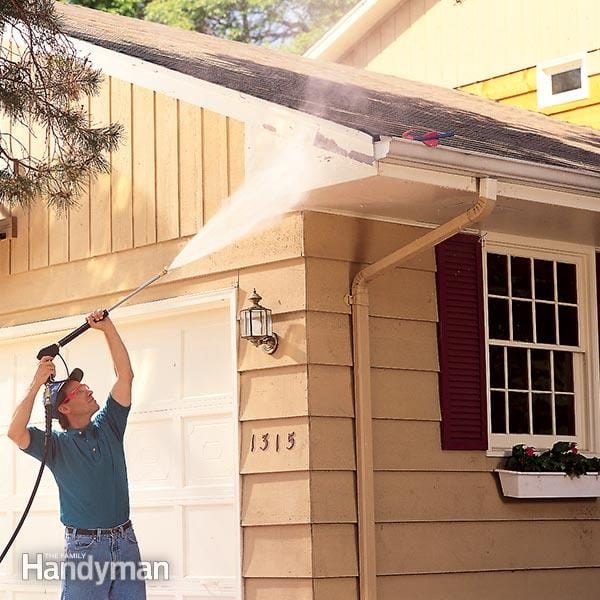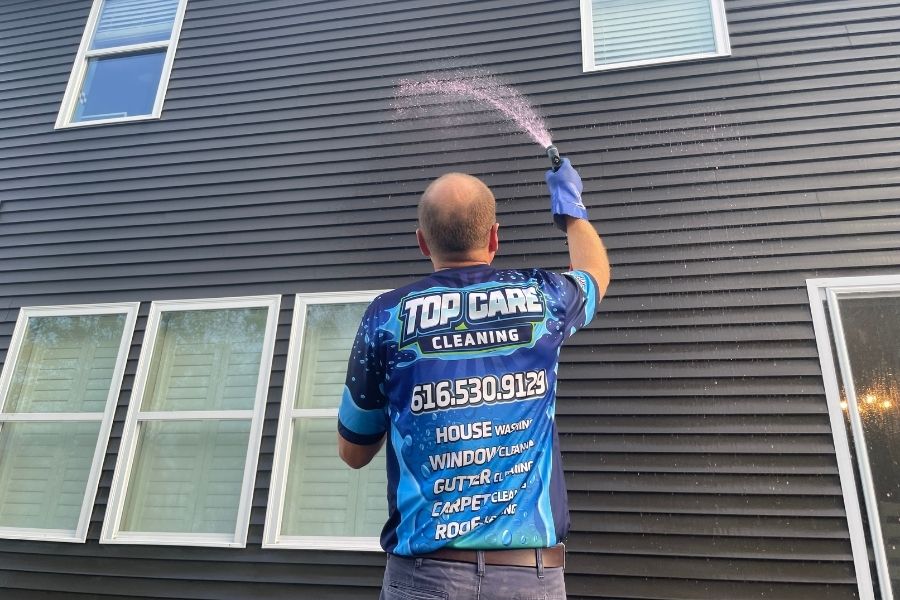Recognizing the Key Differences Between Pressure Washing and Home Washing
The difference in between pressure washing and home washing is critical for property owners wanting to keep their property's exterior. House Washing. While pressure washing utilizes high-pressure water jets to remove stubborn crud from durable surfaces, house washing uses a gentler method that integrates eco-friendly cleansing representatives to shield even more delicate products. Understanding the subtleties between these approaches not just influences cleaning performance yet additionally affects the long life of your surface areas. As we explore these differences, it comes to be apparent that the ideal choice can dramatically impact your home's look and longevity. What variables should you take into consideration when determining in between the 2?
Meaning of Pressure Washing
Pressure washing, frequently described as power washing, entails making use of high-pressure water spray to eliminate dirt, gunk, mold, mildew, and various other contaminants from various surfaces. This method is particularly efficient on hard surface areas such as concrete, brick, and rock, making it a suitable option for cleansing driveways, outdoor patios, and walkways. The process typically uses specialized equipment that creates water pressure ranging from 1,500 to 3,000 psi or more, ensuring effective cleaning even in difficult conditions.
Pressure washing is not restricted to exterior surface areas; it can likewise be utilized for different applications, including cars, exterior furniture, and tools. It is vital to note that the strength of the water pressure can potentially damage fragile surfaces, such as wood or painted surfaces, if not taken care of correctly. As a result, picking the appropriate pressure setting and nozzle kind is essential for optimal outcomes.
Along with surface area cleansing, pressure washing can likewise play a substantial role in keeping the durability of structures by protecting against the accumulation of damaging contaminants that can result in degeneration. In general, pressure washing functions as an effective tool for enhancing sanitation and maintaining the stability of various surfaces.
Interpretation of House Washing
Residence washing describes the detailed cleaning of a home's outside surfaces, using a mix of low-pressure water and specialized cleansing options. This method is created to get rid of dirt, mold, mildew, algae, and various other pollutants that build up in time, preserving the visual appeal and structural stability of the building.
Unlike pressure washing, which employs high-pressure streams of water, home washing emphasizes making use of lower pressure to avoid damage to delicate surface areas such as house siding, roof covering, and repainted finishes. The cleansing services used are typically eco-friendly and developed to effectively take on specific concerns, guaranteeing a complete clean without endangering the atmosphere or the integrity of the materials being treated.
Residence washing is particularly valuable for keeping the look of vinyl, timber, stucco, and brick outsides. Routine home washing not only boosts visual charm however also adds to the durability of a home's exterior surface areas by minimizing the results of harmful bacteria and toxic wastes. House owners are urged to set up residence washing occasionally to ensure their home stays in optimum condition, therefore protecting their investment.
Trick Methods Made Use Of
In the world of exterior cleaning, various methods are employed to attain optimal outcomes during residence washing. The main method includes soft washing, which makes use of low-pressure water integrated with specialized cleansing services. This technique properly gets rid of dirt, algae, and mildew without link damaging fragile surface areas such as wood or repainted home siding.
Another trick method is the use of a surface cleaner accessory, which is specifically efficient for flat surfaces like outdoor patios and driveways. This device offers consistent cleansing by utilizing turning jets that cover a larger location, making sure regular outcomes.
Chemical application is also critical in residence washing. Cleaners such as sodium hypochlorite or eco-friendly detergents are usually utilized to damage down challenging spots and natural development. House Washing. Proper dilution and application techniques are important to minimize any possible damages resource to plants or landscape design
Ideal Surface Areas for every
When identifying the ideal cleansing technique, it's necessary to consider the kinds of surface areas entailed. Pressure washing, which makes use of high-pressure water jets, is finest matched for hard, long lasting surfaces that can endure extreme force. Typical applications include driveways, outdoor patios, pathways, and decks. These surface areas typically gather challenging discolorations, such go now as oil, grease, and mildew, which call for the effective cleansing action provided by pressure washing.
On the various other hand, house washing normally employs a softer approach, utilizing low-pressure water combined with specialized cleaning agents. House washing properly gets rid of dust, plant pollen, and mold without running the risk of damages to the outside finish.
Benefits and Downsides

On the other hand, house washing uses a gentler method, frequently employing a combination of low-pressure water and cleansing solutions. This technique is much safer for repainted surfaces, house siding, and roofs, helping to preserve their integrity. The primary drawback of house washing is that it might not get rid of deeply embedded dirt or stubborn stains as effectively as pressure washing, which can need more time and several applications.

Verdict
In recap, pressure washing and home washing offer distinctive objectives in exterior cleansing. Pressure washing employs high-pressure water streams, making it appropriate for durable surfaces and effective against tough discolorations. On the other hand, home washing uses a low-pressure approach with biodegradable remedies, guaranteeing the safety and security of fragile products. Comprehending these distinctions assists in educated decisions regarding the suitable cleaning method based upon surface type and problem, ultimately promoting effective maintenance and longevity of external surface areas.
 Danny Tamberelli Then & Now!
Danny Tamberelli Then & Now! Ralph Macchio Then & Now!
Ralph Macchio Then & Now! Barret Oliver Then & Now!
Barret Oliver Then & Now! Brandy Then & Now!
Brandy Then & Now! McKayla Maroney Then & Now!
McKayla Maroney Then & Now!